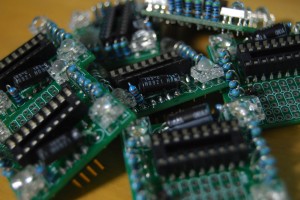I recently began working on a consulting project that required the creation of some PCBs. Since I have had such great success with BatchPCB.com in the past, I decided to use them again to fab the custom PCBs. The BatchPCB purchasing system adds a few static fees (set-up, handling, and shipping), so I felt that this was as good a time as any to make some additional of my PIC16F628 4 RGB LED PWM Controller boards with a couple of modifications.
As I noted in the previous post, there was an error on the first revision of the board and a pull-up resistor on RA5 (pin 4 in the schematic above) was necessary. I added the MCLR resistor to the board along with a couple of other modifications:
- Removed the extraneous capacitors, we only need one.
- Added a breakout for the one remaining I/O pin.
- Added a small perfboard to the PCB with +5V and ground lines.
- Relocated the resistors to make them much easier to solder. I may use a SIL resistor array in the future.
I kept the LED locations exactly the same because, hey, if I put all of the time and effort into the 4 boards that I previously ordered, then I might as well keep the same form factor. My scheme for the short-term is to create a 4×4 array of the 4 RGB LED Controller boards, which will give me a 20cmx20cm 8×8 RGB LED display.
Here are some pictures of the boards:
Here is the updated schematic and board (note, you can open the BRD and SCH files in Eagle Layout Editor):
And finally, here is an updated firmware that improves the PWM performance:
I will make sure to post when I have the full array put together (I currently only have 12 of the 16 boards I need for the 4×4 array).






